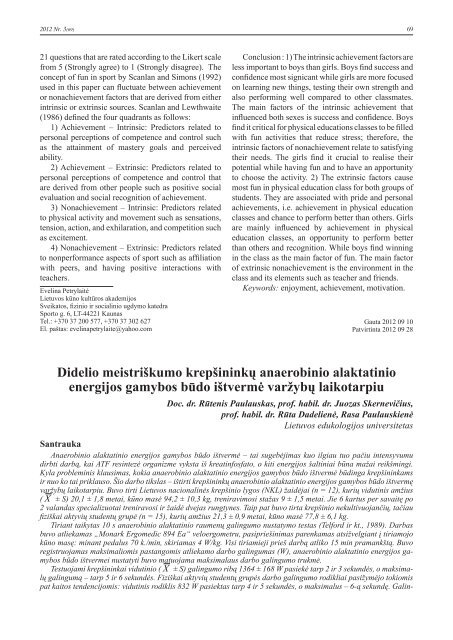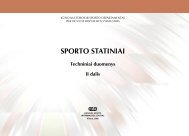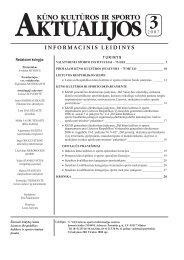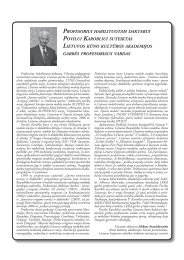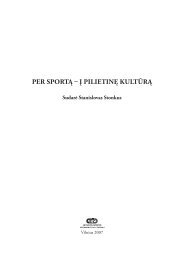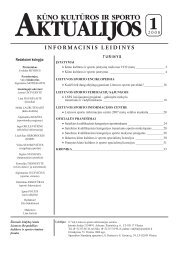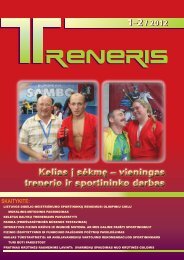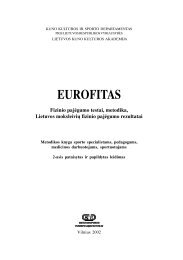Nr. 3 - Lietuvos sporto informacijos centras
Nr. 3 - Lietuvos sporto informacijos centras
Nr. 3 - Lietuvos sporto informacijos centras
You also want an ePaper? Increase the reach of your titles
YUMPU automatically turns print PDFs into web optimized ePapers that Google loves.
2012 <strong>Nr</strong>. 3(69)<br />
69<br />
21 questions that are rated according to the Likert scale<br />
from 5 (Strongly agree) to 1 (Strongly disagree). The<br />
concept of fun in sport by Scanlan and Simons (1992)<br />
used in this paper can fluctuate between achievement<br />
or nonachievement factors that are derived from either<br />
intrinsic or extrinsic sources. Scanlan and Lewthwaite<br />
(1986) defined the four quadrants as follows:<br />
1) Achievement – Intrinsic: Predictors related to<br />
personal perceptions of competence and control such<br />
as the attainment of mastery goals and perceived<br />
ability.<br />
2) Achievement – Extrinsic: Predictors related to<br />
personal perceptions of competence and control that<br />
are derived from other people such as positive social<br />
evaluation and social recognition of achievement.<br />
3) Nonachievement – Intrinsic: Predictors related<br />
to physical activity and movement such as sensations,<br />
tension, action, and exhilaration, and competition such<br />
as excitement.<br />
4) Nonachievement – Extrinsic: Predictors related<br />
to nonperformance aspects of sport such as affiliation<br />
with peers, and having positive interactions with<br />
teachers.<br />
Evelina Petrylaitė<br />
<strong>Lietuvos</strong> kūno kultūros akademijos<br />
Sveikatos, fizinio ir socialinio ugdymo katedra<br />
Sporto g. 6, LT-44221 Kaunas<br />
Tel.: +370 37 200 577, +370 37 302 627<br />
El. paštas: evelinapetrylaite@yahoo.com<br />
Conclusion : 1) The intrinsic achievement factors are<br />
less important to boys than girls. Boys find success and<br />
confidence most signicant while girls are more focused<br />
on learning new things, testing their own strength and<br />
also performing well compared to other classmates.<br />
The main factors of the intrinsic achievement that<br />
influenced both sexes is success and confidence. Boys<br />
find it critical for physical educations classes to be filled<br />
with fun activities that reduce stress; therefore, the<br />
intrinsic factors of nonachievement relate to satisfying<br />
their needs. The girls find it crucial to realise their<br />
potential while having fun and to have an apportunity<br />
to choose the activity. 2) The extrinsic factors cause<br />
most fun in physical education class for both groups of<br />
students. They are associated with pride and personal<br />
achievements, i.e. achievement in physical education<br />
classes and chance to perform better than others. Girls<br />
are mainly influenced by achievement in physical<br />
education classes, an opportunity to perform better<br />
than others and recognition. While boys find winning<br />
in the class as the main factor of fun. The main factor<br />
of extrinsic nonachievement is the environment in the<br />
class and its elements such as teacher and friends.<br />
Keywords: enjoyment, achievement, motivation.<br />
Gauta 2012 09 10<br />
Patvirtinta 2012 09 28<br />
Didelio meistriškumo krepšininkų anaerobinio alaktatinio<br />
energijos gamybos būdo ištvermė varžybų laikotarpiu<br />
Doc. dr. Rūtenis Paulauskas, prof. habil. dr. Juozas Skernevičius,<br />
prof. habil. dr. Rūta Dadelienė, Rasa Paulauskienė<br />
<strong>Lietuvos</strong> edukologijos universitetas<br />
Santrauka<br />
Anaerobinio alaktatinio energijos gamybos būdo ištvermė – tai sugebėjimas kuo ilgiau tuo pačiu intensyvumu<br />
dirbti darbą, kai ATF resintezė organizme vyksta iš kreatinfosfato, o kiti energijos šaltiniai būna mažai reikšmingi.<br />
Kyla probleminis klausimas, kokia anaerobinio alaktatinio energijos gamybos būdo ištvermė būdinga krepšininkams<br />
ir nuo ko tai priklauso. Šio darbo tikslas – ištirti krepšininkų anaerobinio alaktatinio energijos gamybos būdo ištvermę<br />
varžybų laikotarpiu. Buvo tirti <strong>Lietuvos</strong> nacionalinės krepšinio lygos (NKL) žaidėjai (n = 12), kurių vidutinis amžius<br />
( X ± S) 20,1 ± 1,8 metai, kūno masė 94,2 ± 10,3 kg, treniravimosi stažas 9 ± 1,5 metai. Jie 6 kartus per savaitę po<br />
2 valandas specializuotai treniravosi ir žaidė dvejas rungtynes. Taip pat buvo tirta krepšinio nekultivuojančių, tačiau<br />
fiziškai aktyvių studentų grupė (n = 15), kurių amžius 21,3 ± 0,9 metai, kūno masė 77,8 ± 6,1 kg.<br />
Tiriant taikytas 10 s anaerobinio alaktatinio raumenų galingumo nustatymo testas (Telford ir kt., 1989). Darbas<br />
buvo atliekamas „Monark Ergomedic 894 Ea“ veloergometru, pasipriešinimas parenkamas atsižvelgiant į tiriamojo<br />
kūno masę: minant pedalus 70 k./min, skiriamas 4 W/kg. Visi tiriamieji prieš darbą atliko 15 min pramankštą. Buvo<br />
registruojamas maksimaliomis pastangomis atliekamo darbo galingumas (W), anaerobinio alaktatinio energijos gamybos<br />
būdo ištvermei nustatyti buvo matuojama maksimalaus darbo galingumo trukmė.<br />
Testuojami krepšininkai vidutinio ( X ± S) galingumo ribą 1364 ± 168 W pasiekė tarp 2 ir 3 sekundės, o maksimalų<br />
galingumą – tarp 5 ir 6 sekundės. Fiziškai aktyvių studentų grupės darbo galingumo rodikliai pasižymėjo tokiomis<br />
pat kaitos tendencijomis: vidutinis rodiklis 832 W pasiektas tarp 4 ir 5 sekundės, o maksimalus – 6‐ą sekundę. Galin-


